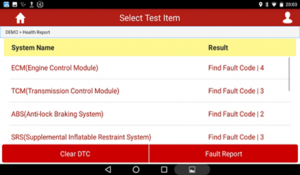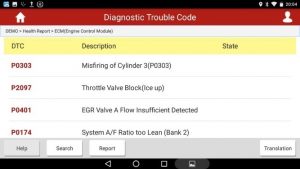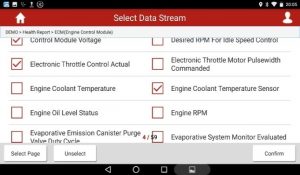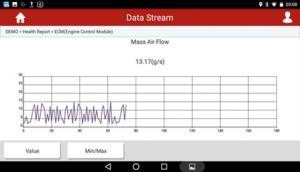ANNUAL OF ASSEN ZLATAROV UNIVERSITY, BURGAS BULGARIA, 2019, v. XLIX (1)

DEVELOPING COMPETENCES BY TRAINING STUDENTS IN AUTOMOTIVE DIAGNOSTICS
Magdalena Dyulgerovа Toncho Boyukov
Е-mail: mdyulgerova@abv.bg toncho_b@abv.bg
btu.bg/images/annual/annual_uni_vol_1_2020.pdf

Abstract
An important factor for building the profile of students in technical specialties is the study of disciplines that provide professional knowledge by forming both key and professional competencies. The student trainig of automotive diagnostics lead to the expansion and extending of the range of competencies. The use of digital technologies for diagnostics in the training of students in technical specialties builds professional competencies for establishing the failure of the car and transferable competencies in personal efficiency and self-improvement.
Key words: technical education, building competences, diagnostic
Introduction
The successful professional adaptation and future career of the graduates is the compliance of the level, character of their professional training, their personal qualities according the requirements of the future professions and business.
However, opinion of many employers is that novice engineers don‘t have enough practical skills. Furthermore they lack key skills such as communication, responsibility, teamwork [1, 3, 4].
Building of educational competences involve acquiring individual knowledge and skills of students as well as the mastery of a complex process, in which a corresponding set of educational components is determined for each selected area. The particularity of goals for the development of competencies is that they are formed not only of the teacher’s actions but as the results of the student activity, development in the process of acquiring a social experience.
The existing social and technical reality today requires workers who are competent both in their professional field and “in a field that, it would seem, is not clearly connected with his professional existence”.
Today there is a need to create competence models for engineering specialists, adapted to specific conditions of professional activity.
An important factor for building the profile of students in technical specialties is the introduction of disciplines that provide professional knowledge by forming both key and professional competencies.The competency profile of a key position contains two main components: a job description and a competency framework – a set of required competencies for the position.
One of the disciplines that build the profile of technical specialties is the diagnostics of machines and systems. The application of the new achievements of science and technology in transport requires the use of both classical methods and new diagnostic tools in the training. New information technologies using the computer facilities and networks give possibility to create a qualitatively new educational environment as a basis for the development and improvement of the education system.
EXPOSITION
Educational policy in technical specialties is aimed at building competencies in the field of engineering and technology.
Competencies are defined as the combined utilization of personal abilities and attributes, skills and knowledge to effectively perform a job, role, function, task, or duty [5].
According to the conceptual model of MyCompetence, the competence is a set of knowledge, skills, attitudes and behaviors of to achieve results (levels of performance) in a given professional role or organization [6].
The competences are an expression of the individual’s ability to do his job successfully. The competences are a concept that is considered in the context of the demonstrated behavior in a specific situation and in the performance of a specific task, role, etc. Competency is closer to „I know how“ than to „I know what“.
The training of students in technical specialties is based on „qualification characteristic“ showing the information about skills which bachelor with technical specialties in transport has to earn.
The specialist, who has acquired a bachelor’s degree in „Engineering and technology in transport“, needs a high professional level in technology for design, manufacture, repair, technical operation of equipment intended for transport of passengers and various types of cargo, incl. liquid cargo and gases. It is necessary to obtain knowledge related to analysis and synthesis of equipment designed for transport of passengers and goods; manufacture, testing, installation, maintenance and repair of equipment for transport of passengers and cargos.
The classification used in MyCompetence formulates cluster competencies by several criteria according to the field – digital, communicative, organizational, professional.
MyCompetence gives 17 clusters of the same type of competencies. Clusters include key and specific competence.
Considering the qualification characteristics of the specialty and the block model of the curriculum [2], it can be concluded that there is a need to build both specific and develop key competencies.
Specific competencies are defined as closely professional, mainly technical and technological knowledge and skills related to the specific nature of the functions performed by a particular position, ie. what employees need to know and be able to do their job successfully and efficiently in accordance with the requirements of the position. These competencies are related to the specific nature of the profession and the tasks of the position (workplace), to the equipment, tools and technology used, to the business processes and operations, to the specific regulations and standards to which the position relates.
Competences are universal, transferable and unique competencies.
Transferable competencies include skills and abilities needed to perform several roles in varying degrees of importance and mastery.
Unique competencies refer to specialized know-how or abilities required within a specific role or job.
Technical competencies include the underlying knowledge and skills “the portion of the iceberg that remains above the surface of water”, described in observable and measurable terms that are necessary in order to perform a particular task assigned to a person achieving quantitative target and conforming to qualitative requirement.
The development of the competence profile of the engineer in the educational process is limited by the provided hours and this requires the selection of competencies from the 17 clusters.
One of the disciplines forming the profile of the engineer is diagnostics of the transport equipment. It is studied in the fourth year, and in advance the students are acquainted with the general principles of reliability of transport units and systems, with concepts such as failures, operability, maintainability and others. The students have deepened the logical thinking, they have understood the quality as a necessary element for the reliability of both a single element and complex systems, in the design and operational stage.
The study of car diagnostics should lead to the expansion and deepening of the range of competencies. The choice of competencies was made after analysis of the clusters from MyCompetence, taking into account the Bulgarian qualifications framework. According to MyCompetence, the competencies are specific, and according to Europass – professional.
It was chosen to focus on specific/professional competencies from three clusters – Working with regulations, standards and requirements, Repair and maintenance, Design, development and implementation.
In parallel, transferable (according europass – organisational) competencies from the cluster Personal Efficiency and Self-Improvement are deepened during the training. The training begins with the formation of the competencies from the cluster Working with regulations, standards and requirements:
– Application of health and safety standards – acquaintance with the instructions, rules and regulations for health and safety at work, environmental protection, and fire and emergency safety in the performance of their daily duties. Strict observance of all rules is exercised, emphasizing the fact that transport is a high-risk sector.
– Application of normative regulations and standards – acquaintance with the application of the requirements of the specific for the automotive sector standards.
– Compliance with standards and norms – examples are given of situations that show the need for their timely and complete implementation, strictly adhering to the norms and standards adopted by the company. In the training there is an opportunity to conduct practical training in a real work environment in a partner company.
After understanding the importance of knowledge and compliance with standards and rules, classes are held to form competencies from the cluster Repair and maintenance:
– Diagnostics of motor vehicles – the aim is to form competencies for organizing and performing in the correct technological sequence diagnostics, determining the technical condition of the mechanisms, systems and units of conventional and electric vehicles.
– Caring for the technical condition of the vehicle – competencies for understanding the vehicle as a system, for systematic and precise control of the technical condition of the vehicle, detection of technical malfunctions that pose a risk to safe movement and taking appropriate reliable measures for their removal.
– Maintenance of systems and equipment – performs inspection, diagnostics and maintenance of systems and equipment, strictly observing the standards for their proper and appropriate maintenance.
– Damage prevention – timely identifies and prevents the occurrence of risks of damage and accidents.
– Operation of a motor vehicle – performs maintenance activities on the motor vehicle, observing the legal framework regarding the requirements for technical condition of vehicles.
In parallel with the construction of the listed competencies, it is being upgraded:
– analysis of test data definition interprets and analyzes the data collected during the tests, formulating conclusions, new ideas or solutions. type specific.
The selected competencies are the basis for the construction of professional competencies: Carrying out repair activities, Repair of motor vehicles, Service, which are formed in other following disciplines of the curriculum.
The development of professional competencies also determines the parallel development of transferable (organizational according to Europass) competencies, which are summarized in the cluster Personal Efficiency and Self-Improvement. In car diagnostics training, opportunities are created to develop key competencies needed for many other areas.
А special place is occupied by the development of observation, concentration and sustainability of attention. Тhese competencies develop as a result of learning the two methods of diagnosis – subjective, through which probable failures can be observed visually, by smell, noise detection and objective – by onboard diagnostic or outboard external scanners. The system approach is used by setting tasks for purposeful focusing on a certain system of the car, its elements, their individual characteristics and details. It is necessary to concentrate on a specific goal, object, process, activity, operation, signal, etc. At the same time logical thinking is developed, and conclusions are drawn from the collected information. Decisions to determine the failure are made on the basis of monitoring and analysis of the situation. Practical-active thinking is built depending on a preliminary purpose, based on visual, auditory and other perceptions in the process of manipulating objects. Student can reach new knowledge in the form of concepts and ratiocinations about their properties and spatial-object relations.
The use of modern computerized methods is very effective in building the key and professional competencies for detecting vehicle failures.
Each vehicle is equipped with an onboard computer. Onboard diagnostic (OBD) information systems are designed to automatically monitor and record the data of a technical condition, the correct technical operation of vehicles and driver performance.
Modern vehicles use on-board computers which control fuel metering (fuel injection), actuate EGR and purge valves, etc., regulate anti-lock braking, control transmission. OBD II is an extension of the computer. The tester, which is an example of outboard diagnostics, is required to access the stored problem code. The issue of outboard diagnostics is the analysis of the fault code of the control units.
A fundamental step in establishing the causes of reliability is the choice of a fault-finding algorithm. To achieve efficiency is the logical approach to look for possible damage.
CRP MOT diagnostic equipment was used for building competencies in diagnostics. All the information for diagnostics is displayed on the LCD graphic display of the tester. CRP MOT is a multibrand diagnostic scaner, including more than 48 car brands with diagnostic cabablities for all available in the car electronic systems and 10 moust common used special functions and basic adaptations. The equipment is built basing on complete Android (fig.1). The set includes also more common used adapters BMW-20 pin and MB-38 pin for old sockets.
Fig. 1 Diagnostic tester.

Fig. 2 Test menu

It can be considered as an example Diagnostics of engine failure (fig. 3). In addition to the numeric code, some diagnostic units also provide a definition of the fault code. This facilitates decision-making for subsequent diagnostic work.

Fig. 3 Function choice

Fig. 4 Selection of test item.
The initial information on the possible cause of the damage is stored here (fig. 5). The specified fault code does not necessarily refer to actual component failure. Before replacing individual components, read this information carefully to determine the next diagnostic steps. It is possible to monitor the parameters in real time in graphical form (fig.6). Concentration an professional knowledge are required to analyze the information and establish the failure of the element.

Fig. 5 Read parameters / measured value block.

Fig. 6 Monitoring of parameters.
During the practical task, all values that are measured, monitored and evaluated, as well as the reference values of the system are recorded and then formed in written form as a protocol.
CONCLUSION
The use of digital technologies for diagnostics in the training of students in technical specialties builds professional competencies for establishing the failure of the car. Skills are formed to know the error codes given by the on-board computer, the symptoms of probable failure, possible causes, possible solutions and transferable competencies in personal efficiency and self-improvement.
REFERENCES
- Chantov, V. Competencii i kompetentnost (me-zhdu znanieto i mozheneto). Novi informacionni tehnologii v obrazovatelniya process, 2012, in Bulgarian
- Dyulgerova, M. Izpolzwane na strukturno-blokow model za razkriwane na mezhdupred-metnite wryzki pri obuchenieto v tehnicheskite specialnosti., Assen Zlatarov University Annual, Vol. XLV, Book 1, 2016, Burgas, in Bulgarian
- Myagkov, A. Studenti tehnichekogo wuza: profesionalynie kompetencii i ovidaniya na rinke truda. Sociologicheskie issledowaniq, 2016, № 6, in Russian
- Piralova, O. Teoreticheskie osnovi optimizacii obucheniq profesionalynim disciplinam v usloviyah sovremennogo technicheskogo vuza. Akademia estestvoznaniya, 2011, in Russian
- https://ec.europa.eu/esco/portal/skill
- https://mycompetence.bg/bg/static/9
7.http://machines.competencemap.bg/language/ bg/uploads/files/analysis1/analysis
 ENGINEERING AND TECHNOLOGY IN TRANSPORT Diagnostics and repair
ENGINEERING AND TECHNOLOGY IN TRANSPORT Diagnostics and repair
